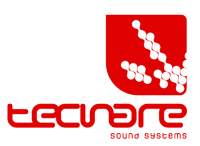1. Innovations in DSP, Active Speakers, and Wireless Systems
Digital Signal Processing (DSP) Innovations
DSP has revolutionized the way we handle audio, providing better sound quality, more efficient control, and a greater ability to customize sound in various environments. Innovations in DSP technology have improved how we manage sound signals, resulting in enhanced audio performance and system efficiency.
Adaptive DSP Algorithms
One of the most notable advancements in DSP technology is the use of adaptive algorithms that can adjust to changing acoustics in real-time. These systems analyze the room’s characteristics and modify parameters such as EQ, delay, and compression, providing consistent sound quality regardless of environmental factors.
For instance, advanced DSP systems like the Tecnare DP4896 can integrate real-time processing, enabling seamless adaptation to changing sound environments during live events. With sophisticated algorithms for frequency shaping, dynamic control, and loudspeaker optimization, these systems ensure high performance even in acoustically challenging spaces.
Integration with AI and Machine Learning
Artificial intelligence (AI) and machine learning are starting to play a larger role in DSP systems. These technologies can help optimize sound quality by analyzing data collected from microphones and other sensors in real time. For example, AI can help in feedback suppression, noise reduction, and frequency analysis, offering more intelligent, automated system adjustments.
Active Speakers
Active (powered) speakers have become more popular due to their integrated amplifiers and built-in signal processing. This eliminates the need for separate power amplifiers and external DSP units, simplifying system setup and reducing the overall footprint.
Innovative Active Speaker Designs
Recent advancements in active speaker technology include the development of bi-amplified designs, where separate amplifiers power the low-frequency (LF) and high-frequency (HF) drivers, allowing for greater efficiency and sound fidelity. Companies like Tecnare have introduced active speaker models that combine high-efficiency amplifiers, custom drivers, and onboard DSP.
Wireless Audio Systems
The integration of wireless technology into sound systems has been one of the most significant developments in recent years. Wireless audio systems eliminate the need for cumbersome cables, offering flexibility and ease of setup.
Low-Latency, High-Quality Wireless Transmission
Emerging technologies like Wi-Fi 6 and 5G networks are facilitating faster, more reliable wireless audio transmission. These systems offer low-latency performance, ensuring synchronization between audio sources and playback systems. Moreover, Bluetooth 5.0 and proprietary Wi-Fi-based protocols have increased the range and quality of wireless audio, making it ideal for live events and installations.
Trends in Audio in Network and Remote Control Systems
Audio-over-IP (AoIP)
One of the most transformative innovations in the audio industry is Audio-over-IP (AoIP). This networked audio technology enables high-quality digital audio transmission over standard Ethernet networks, replacing traditional analog and point-to-point connections.
AoIP systems offer several advantages, including:
- Scalability: Audio can be routed across complex systems with thousands of channels.
- Flexibility: AoIP enables the sharing of audio between devices in different locations over the network.
- Reduced cabling and infrastructure costs: With AoIP, you can use existing network infrastructure to transmit audio, minimizing the need for expensive dedicated cabling.
Technologies like Dante, AVB (Audio Video Bridging), and AES67 are leading the way in AoIP, allowing devices from different manufacturers to communicate seamlessly across the same network. This is particularly advantageous for large-scale installations in venues like stadiums, arenas, and concert halls.
Remote Control and Monitoring Systems
Advancements in remote control and monitoring systems have given sound engineers the ability to manage and adjust system settings from a distance, either via a dedicated controller or mobile devices. These systems can monitor performance in real time, provide diagnostic feedback, and allow for adjustments without needing to be physically present at the equipment.
- Mobile Apps and Cloud-Based Control: Many sound systems now offer apps or cloud platforms for remote control and monitoring, making it easier to manage sound systems across different venues or locations.
- Real-Time Monitoring of System Health: Advanced systems can now alert operators to potential issues, such as overheating or power loss, so they can take action before any performance issues arise.
Trends in the Industry and How to Stay Updated
The audio industry is evolving rapidly, with continuous advancements in technology that drive new capabilities and efficiencies. Below are the current trends and how professionals can stay up to date:
Trends in the Audio Industry
Immersive Audio Technologies
Immersive audio technologies, such as Dolby Atmos and DTS:X, are becoming more prevalent in both live sound and studio environments. These technologies allow for 3D soundscapes, providing a richer, more dynamic listening experience. They are especially useful in applications such as film soundtracks, gaming, and live concerts.
Sustainability and Eco-Friendly Products
Sustainability is a growing concern in all industries, and the sound sector is no exception. Many manufacturers are now focusing on creating energy-efficient and environmentally friendly products. These include energy-efficient amplifiers, recyclable speaker components, and sustainable packaging. The adoption of such technologies is essential for companies that want to meet environmental standards and consumer expectations.
Increased Use of Streaming and On-Demand Audio
With the rise of streaming platforms and on-demand content, professionals must stay up-to-date with the latest in streaming technology. Innovations in high-resolution audio streaming and adaptive bit-rate streaming have made it possible to deliver high-quality audio over the internet, improving the user experience for consumers.
Conclusion
Emerging technologies in DSP, active speakers, wireless systems, and networked audio are shaping the future of the sound industry. As these technologies continue to evolve, it’s essential for audio professionals to stay informed about the latest trends and developments.
By embracing innovations in DSP, leveraging the benefits of AoIP, and utilizing remote control systems, professionals can optimize their audio systems for improved performance and flexibility. Furthermore, staying updated on industry trends such as immersive audio, sustainability, and the rise of streaming platforms will allow professionals to remain competitive and deliver the best possible experiences to their clients and audiences.
